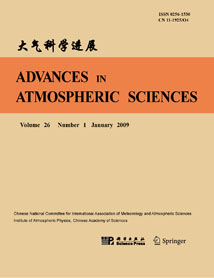| [1] |
Liang ZHANG, Bin ZHU, Jinhui GAO, Hanqing KANG,
2017: Impact of Taihu Lake on City Ozone in the Yangtze River Delta, ADVANCES IN ATMOSPHERIC SCIENCES, 34, 226-234.
doi: 10.1007/s00376-016-6099-6
|
| [2] |
Ruosi ZHANG, Shang-Ping XIE, Lixiao XU, Qinyu LIU,
2016: Changes in Mixed Layer Depth and Spring Bloom in the Kuroshio Extension under Global Warming, ADVANCES IN ATMOSPHERIC SCIENCES, 33, 452-461.
doi: 10.1007/s00376-015-5113-8
|
| [3] |
LIU Chengyan* and WANG Zhaomin, ,
2014: On the Response of the Global Subduction Rate to Global Warming in Coupled Climate Models, ADVANCES IN ATMOSPHERIC SCIENCES, 31, 211-218.
doi: 10.1007/s00376-013-2323-9
|
| [4] |
Yue SUN, Huiling YANG, Hui XIAO, Liang FENG, Wei CHENG, Libo ZHOU, Weixi SHU, Jingzhe SUN,
2024: The Spatiotemporal Distribution Characteristics of Cloud Types and Phases in the Arctic Based on CloudSat and CALIPSO Cloud Classification Products, ADVANCES IN ATMOSPHERIC SCIENCES, 41, 310-324.
doi: 10.1007/s00376-023-2231-6
|
| [5] |
Chengyan LIU, Zhaomin WANG, Bingrui LI, Chen CHENG, Ruibin XIA,
2017: On the Response of Subduction in the South Pacific to an Intensification of Westerlies and Heat Flux in an Eddy Permitting Ocean Model, ADVANCES IN ATMOSPHERIC SCIENCES, 34, 521-531.
doi: 10.1007/s00376-016-6021-2
|
| [6] |
Xinyi XING, Xianghui FANG, Da PANG, Chaopeng JI,
2024: Seasonal Variation of the Sea Surface Temperature Growth Rate of ENSO, ADVANCES IN ATMOSPHERIC SCIENCES, 41, 465-477.
doi: 10.1007/s00376-023-3005-x
|
| [7] |
SUN Jianning, JIANG Weimei, CHEN Ziyun, YUAN Renmin,
2005: Parameterization for the Depth of the Entrainment Zone above the Convectively Mixed Layer, ADVANCES IN ATMOSPHERIC SCIENCES, 22, 114-121.
doi: 10.1007/BF02930874
|
| [8] |
ZHANG Lifeng, WANG Xingbao, ZHANG Ming,
2003: Spatial and Time Structure of a Gravity Wave in Horizontal Atmosphere of Heterogeneous Stratification, ADVANCES IN ATMOSPHERIC SCIENCES, 20, 29-36.
doi: 10.1007/BF03342047
|
| [9] |
Ge Ling, Liang Jiaxing, Chen Yiliang,
1996: Spatial / Temporal Features of Antarctic Climate Change, ADVANCES IN ATMOSPHERIC SCIENCES, 13, 375-382.
doi: 10.1007/BF02656854
|
| [10] |
GAO Shouting, Xiaofan LI,
2009: Dependence of the Accuracy of Precipitation and Cloud Simulation on Temporal and Spatial Scales, ADVANCES IN ATMOSPHERIC SCIENCES, 26, 1108-1114.
doi: 10.1007/s00376-009-8143-2
|
| [11] |
Fanglin WANG, Wei DU, Shaojun LV, Zhijian DING, Gehui WANG,
2021: Spatial and Temporal Distributions and Sources of Anthropogenic NMVOCs in the Atmosphere of China: A Review, ADVANCES IN ATMOSPHERIC SCIENCES, 38, 1085-1100.
doi: 10.1007/s00376-021-0317-6
|
| [12] |
Hengyi Weng,
1992: Spatial and Temporal Variations of Blocking and Cyclogenesis in the 1978 / 79 Winter, ADVANCES IN ATMOSPHERIC SCIENCES, 9, 411-430.
doi: 10.1007/BF02677074
|
| [13] |
P.C. Chu, Roland W. Garwood, Jr.,
1990: Thermodynamic Feedback between Clouds and the Ocean Surface Mixed Layer, ADVANCES IN ATMOSPHERIC SCIENCES, 7, 1-10.
doi: 10.1007/BF02919163
|
| [14] |
Jiang Weimei, Yu Hongbin,
1994: Study on the Thermal Internal Boundary Layer and Dispersion of Air Pollutant in Coastal Area by Numerical Simulation, ADVANCES IN ATMOSPHERIC SCIENCES, 11, 285-290.
doi: 10.1007/BF02658147
|
| [15] |
CHEN Bin, XU Xiang-De, YANG Shuai, ZHANG Wei,
2012: On the Temporal and Spatial Structure of Troposphere-to- Stratosphere Transport in the Lowermost Stratosphere over the Asian Monsoon Region during Boreal Summer, ADVANCES IN ATMOSPHERIC SCIENCES, 29, 1305-1317.
doi: 10.1007/s00376-012-1171-3
|
| [16] |
Xiaofan LI, SHEN Xinyong,
2012: Temporal and Spatial Scale Dependence of Precipitation Analysis over the Tropical Deep Convective Regime, ADVANCES IN ATMOSPHERIC SCIENCES, 29, 1390-1394.
doi: 10.1007/s00376-012-1269-7
|
| [17] |
PENG Jie, ZHANG Hua, Zhanqing LI,
2014: Temporal and Spatial Variations of Global Deep Cloud Systems Based on CloudSat and CALIPSO Satellite Observations, ADVANCES IN ATMOSPHERIC SCIENCES, 31, 593-603.
doi: 10.1007/s00376-013-3055-6
|
| [18] |
Ting HUA, Xunming WANG,
2018: Temporal and Spatial Variations in the Climate Controls of Vegetation Dynamics on the Tibetan Plateau during 1982-2011, ADVANCES IN ATMOSPHERIC SCIENCES, 35, 1337-1346.
doi: 10.1007/s00376-018-7064-3
|
| [19] |
Xiaohua XU, Daocheng YU, Jia LUO,
2018: The Spatial and Temporal Variability of Global Stratospheric Gravity Waves and Their Activity during Sudden Stratospheric Warming Revealed by COSMIC Measurements, ADVANCES IN ATMOSPHERIC SCIENCES, 35, 1533-1546.
doi: 10.1007/s00376-018-5053-1
|
| [20] |
Bozhen LI, Gen ZHANG, Lingjun XIA, Ping KONG, Mingjin ZHAN, Rui SU,
2020: Spatial and Temporal Distributions of Atmospheric CO2 in East China Based on Data from Three Satellites, ADVANCES IN ATMOSPHERIC SCIENCES, 37, 1323-1337.
doi: 10.1007/s00376-020-0123-6
|















 AAS Website
AAS Website 
 AAS WeChat
AAS WeChat 
 DownLoad:
DownLoad: